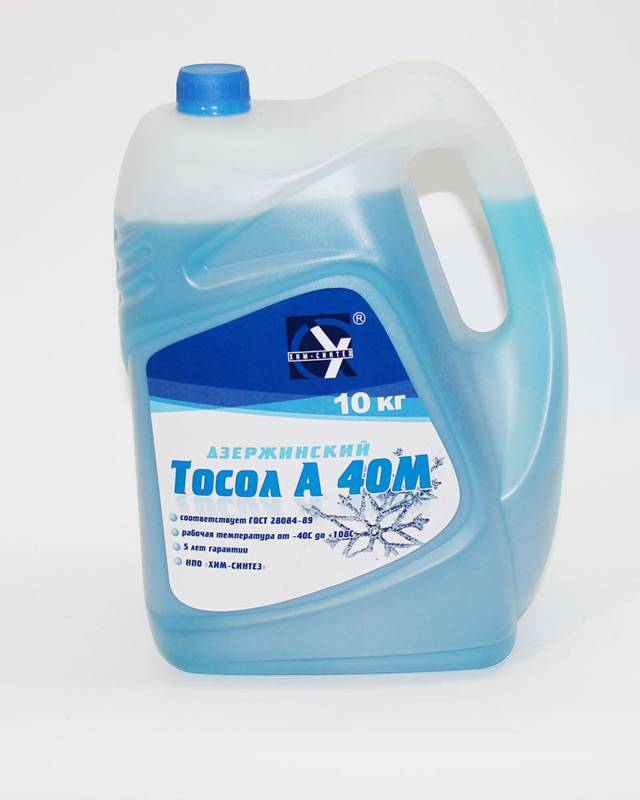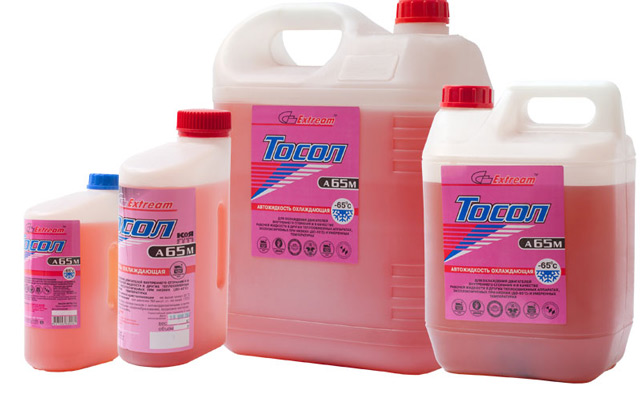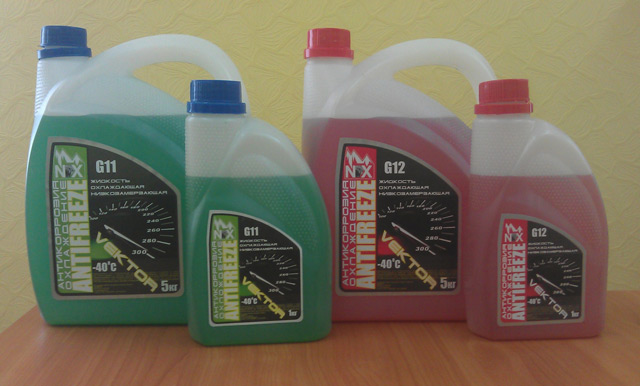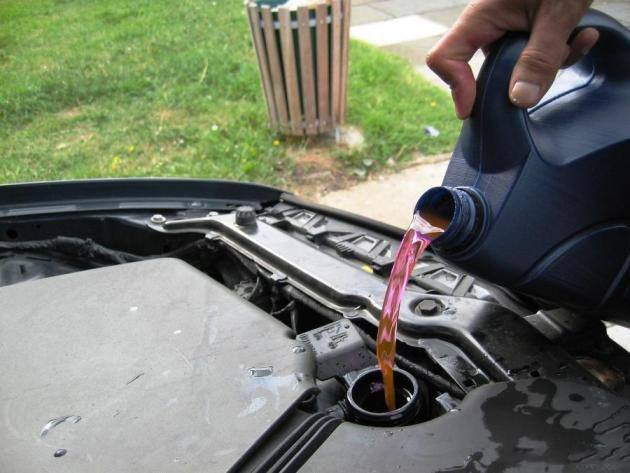Antifreeze or toosol - the better cool the car engine?
So, consider: What is better toosol or antifreeze and what is the difference between antifreeze antifreeze? Antifreeze (antifreeze) is an English-speaking word that came to us from European countries, and literally means - "preventing freezing, non-freezing liquid", which actually is Tosol. Antifreeze can be compared with oil. There is a huge number of titles, but no matter how it is called and where it has been done - it will still be oil. And Tosol is antifreeze, since it is only a trademark, i.e. antifreeze of domestic production under the Tosol brand.
But even foreign antifreeze has a number of different parameters, and. There is antifreeze better, eat and worse. And our domestic toosol according to its quality and characteristics is quite different from foreign analogues. Therefore, before you choose that it is better to pour into the cooling system "Move", it is necessary to understand well, which is one or another liquid.
Tosol
The development of a fluid began in the Soviet Union, specifically on the order under construction at that moment, therefore Tosol was created specifically for domestic cars, and to be more accurate, then for the model "Zhiguli". As a result, two types of coolant with the "-40" and "-65" designations were created. The difference between them is small and lies in thermal characteristics. The temperature at which the freezing of the first is -40 degrees Celsius, respectively, the second - sixty-five degrees below zero. The boiling point of both products is the same and amounts to approximately +110 degrees Celsius.
There are also external differences between them. The difference is. And if Tosol "-40" has a blue color, then Tosol "-65" carries a red dye.

Color additives are used to make it easier to determine the fluid level in the expansion tank, because colorless toosol see through the non-very transparent walls of the white tank is extremely difficult. The best color helps in search of leaks, and when highlighting a special lamp, the dye acquires luminescent properties, due to which it is possible to reveal the source of the leak. Also using the color is best determined when you need to change Tosol. After all, in addition to ethylene glycol and water in the liquid there are still many special additives that do not develop corrosion, as well. And the life of these additives and dyes is naturally not infinite and depends on the operating conditions.

If Tosol initially has a blue color, then soon it will become a blue-green, then green, then yellow, after which it will finally lose color. The time for which Tosol will be able to change color, directly depends on the conditions of its operation. If the temperature of the "engine" during operation will not exceed the ninety of five degrees Celsius, then in this case the period of time between blue and yellow will be approximately six hundred working hours. If the "engine" is subjected to systematic overheating, and the temperature reaches the boiling point, the time for which Tosol can change color from blue to yellow, will be about 500 working hours.
The working period of anti-corrosion additives, as well as the dye, depends on the temperature of the "engine", and the rate of deposit wear is equal to the color change rate. Thus, the color will tell how toosol is worn out and whether it is necessary to change it.
Antifreeze of foreign production
So, let's figure it out that it is not a domestic antifreeze, and is there any difference between foreign cooling fluids. As part of foreign antifreeze, as in Tososol, there is water, antifreeze itself (non-freezing substance) and a huge set of all sorts of additives. However, in Tososol these additives there are about ten, but the antifreeze on average contains from 30 to 40 different chemical additives, which actively contribute. The most common foreign antifreeze is made of ethylene glycol, however, there are more rare copies of the non-freezing substance, which are used in very expensive cooling fluids. For example, antifreeze can be based on propylene glycol, potassium, carbitols, as well as based on various alcohols.
European antifreeze is divided into several segments, and differs among themselves both in composition and according to the characteristics. A distinctive feature of the segments is the color palette, which does not coincide with the colors and properties of domestic liquids. And if the toosol with antifreeze is the same color, then this does not mean that they have the same properties. For example, red toosol with antifreeze can be very different in composition and have a different base.
So, let's get acquainted with what kinds of foreign liquids are. Total there are four types of cooling fluids:
Traditional Antifreeze (Traditional Coolants)
The oldest kind of liquids, has already come out of a market trend abroad, but is still widespread in the territory of the former USSR. The basis is ethylene glycol, and inorganic additives from silicates, nitrates, nitrites, phosphates, and so on, are used as anti-corrosion additives.
Failure to foreigners from this type is due to ineffective inorganic additives, the service life of which in normal conditions of operation is a maximum of 2 years. Another negative feature is the deposition in the cooling system of anti-corrosion additives, which have contacted their time. Supplements cover the entire system by a hard-sized silicate coating, due to which the systematic engine overheating appears and as a result - the direct path in the car service is provided. Tosol also refers to this group, and to distinguish Tosol from the antifreeze of this species is almost impossible.
Hybrid Antifreeze (Hybrid COOLANTS) G-11

This antifreeze is already out of category more modern and efficient. The main component is ethylene glycol, but additives have changed. A mixture of inorganic and carboxylate (organic) additives, hence the name "hybrid" is used. Nitrites are used as inorganic additives, the Europeans for these purposes use silicates, and the Japanese and Koreans prefer to use phosphates. The presence of the organic is better protecting the cooling system, and also significantly increases the operational period that ranges from three to five years. Antifreeze of this group on European standards should have a green color.
Carboxylate Antifreeze (CarBoxilate COOLANTS) G-12, G-12 +
This group is better than the previous two parameters. Ethylene glycol is still used as the main component, and only a organic applies as additives.

The service life of such substances starts from five years. Anti-corrosion protection is quite better than those described above. Such indicators were achieved at the expense of "smart" organic additives, which are concentrated exclusively at the places of corrosion origin. A small layer of 0.1 microns is enveloped corrosive hearth, thereby preventing further distribution, and without reducing the heat exchange between the system and the engine. Antifreeze of this class on the European Regulations should have red color.
Lobrid Antifreeze (Lobrid COOLANTS) G-12 ++, G-13
For environmentally friendly cars, there is nothing better than this type. The most non-toxic and all existing at the moment. The difference between this group and the previous ones is the main component. If ethylene glycol played the basis of the role in the above role, then this role took on a safe and fast-prescribing propylene glycol.
However, such a manipulation with the main component led to a significant drawback, which lies in the boiling point. All the aforementioned groups have a higher boiling point. High price also does not give this category to compete, for example, with G-12 and G-12 +. As for the additives, the hybrid technology is again used - mixing organic and mineral additives. European regulations for this group were assigned yellow and orange colors.
What to choose
So what is still toosol or antifreeze? Of course, it is better to pour antifreeze. Tosol was developed for the Zhiguli and subsequently for other outdated VAZ models, and for such cars it is better to pour Tosol, as antifreeze can negatively affect not only the cooling system, but also on the engine as a whole.
Choosing toosol or antifreeze, you need, first of all, be guided by the manufacturer's recommendations. And the best for the car will be what the autocontracean inspired in it. If the toosol flooded - it means it is better to use antifreeze if poured, for example, antifreeze G-12 means it is better to pour G-12. Because automakers are made differently and cooling systems, and engines. In the manufacture of various materials are used, and some can adversely interact with antifreeze, while others, on the contrary, can conflict with toosols and unexpected corrosion, cordored gaskets and so on. For example, many make-up bearings for pumps from ceramic materials, cooling fluids based on ethylene glycol are categorically not recommended for such cars, and antifreeze with glycerol base are produced for them.
If you choose what was presented in the article, then the best will definitely be carboxylate antifreeze G-12, G-12 +. This type has many advantages, such as durability, efficiency, reliability and.
Combination of liquids
The eternal concern of most car enthusiasts is whether antifreeze can be mixed with antifreeze? You can mix Tosol only with a group of traditional antifreeze, because they are almost the same in their composition and properties. If Tosol is mixed with a higher class antifreeze, then the consequences may be much more serious than it may seem at first glance. By adding such antifreeze to Tosol, you can get a complete loss of additives and other additives, they all fall in the system, and not only will not protect it, but they themselves will contribute to the speedy wear. By adding antifreeze to Tosol, pay attention to the main component, for the interaction of different bases will cause hazardous chemical reactions, the results of which can be poisonous, heavy evaporation capable of entrusting serious poisoning.

After buying a car sooner or later, the moment occurs when it is necessary to change the coolant. In most cases, car enthusiasts do not know what fluid spent their time has spent their time, and questions appear - how to identify antifreeze or antifreeze, how to find out what the manufacturer has filled? It will be much easier, and determine what was used earlier, it is possible for the term that has passed since the purchase by comparing it with the terms of exploitation of various antifreezes and toosas. But it is best to know the recommendations of the automaker and pour what it recommends.
Summing up, we want to say: if you compare antifreeze and antifreeze - the difference between them is definitely present. But whoever says, and each of the products adequately copes with its tasks, but only in the environment for which they were developed. And if you don't pour into the radiator, but to use what the automaker advises, then no corrosion and other troubles will arise as a result of another replacement. Purchase Tosol or antifreeze only in reliable and proven sales points, it is not necessary to chase the cheapness, for then overpaid at times more.














